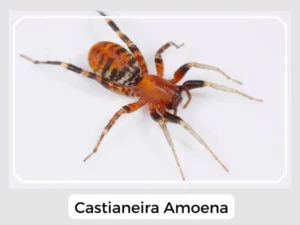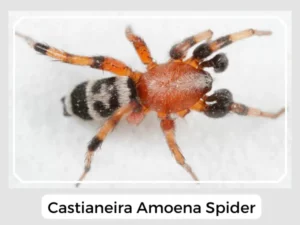Step into the world of the Castianeira amoena spider! This unique crawler is part of the Corinnidae spiders family. It has special colors and patterns that warn other animals to stay away. Join us to discover fun facts about this brightly marked spider!

Photo Credit: Patrick Coin
The eggs are covered in a sac made of webbing.
The spiderlings use their webs to become airborne and travel.
They produce strands of silk to prevent them from falling.
Yes, Castianeira amoena spiders have venom. They use it to snag their favorite meals. For most humans, this venom doesn’t cause big problems.
They can indeed! While their bite is known to sting, it isn’t deadly to humans. It’s best to let them be and watch their pretty patterns from a distance.

Photo Credit: Patrick Coin
The Castianeira amoena spider is an important predator in its habitat. It plays a role in controlling the populations of the insects it preys upon, like ants, which can become pests if not kept in check.
Natural Predators: Despite their warning coloration, they are still at risk from predators that can overlook their mimicry or are immune to their venom, such as certain birds or larger insects.
Prey-Predator Dynamics: Their predatory behavior is beneficial for the ecological balance, ensuring that insect populations do not explode and cause ecological damage.
Relationship with Humans: The relationship between humans and Castianeira amoena is largely unobtrusive. While their venom is not harmful to us, it’s important to appreciate their role from afar and avoid disturbing them, allowing them to continue their beneficial work in nature.
| Lifespan | 1-3 years |
| Distribution | The United States and Mexico |
| Habitat | Woods |
| Diet | Small insects like ants |
In summary, the Castianeira amoena spider is a wasp-mimicking predator, beneficial for controlling pests, with minimal impact on humans.
Step into the world of the Castianeira amoena spider! This unique crawler is part of the Corinnidae spiders family. It has special colors and patterns that warn other animals to stay away. Join us to discover fun facts about this brightly marked spider!

Photo Credit: Patrick Coin
The eggs are covered in a sac made of webbing.
The spiderlings use their webs to become airborne and travel.
They produce strands of silk to prevent them from falling.
Yes, Castianeira amoena spiders have venom. They use it to snag their favorite meals. For most humans, this venom doesn’t cause big problems.
They can indeed! While their bite is known to sting, it isn’t deadly to humans. It’s best to let them be and watch their pretty patterns from a distance.

Photo Credit: Patrick Coin
The Castianeira amoena spider is an important predator in its habitat. It plays a role in controlling the populations of the insects it preys upon, like ants, which can become pests if not kept in check.
Natural Predators: Despite their warning coloration, they are still at risk from predators that can overlook their mimicry or are immune to their venom, such as certain birds or larger insects.
Prey-Predator Dynamics: Their predatory behavior is beneficial for the ecological balance, ensuring that insect populations do not explode and cause ecological damage.
Relationship with Humans: The relationship between humans and Castianeira amoena is largely unobtrusive. While their venom is not harmful to us, it’s important to appreciate their role from afar and avoid disturbing them, allowing them to continue their beneficial work in nature.
| Lifespan | 1-3 years |
| Distribution | The United States and Mexico |
| Habitat | Woods |
| Diet | Small insects like ants |
In summary, the Castianeira amoena spider is a wasp-mimicking predator, beneficial for controlling pests, with minimal impact on humans.